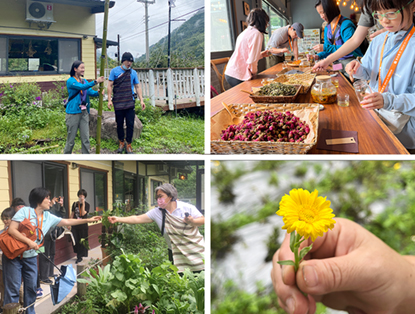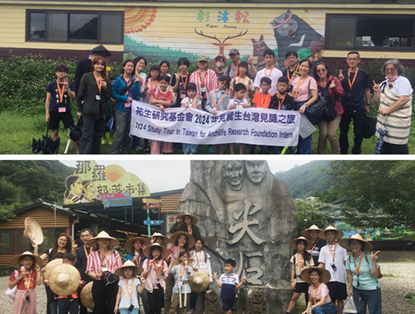Sketch of Archilife Study Tour, June 2024Date: 2024-07-13
Section: Activity |  2024年6月2日由呂明澐小姐帶領26位見習生及其家長們,進行尖石那羅部落巡禮暨芳療香草體驗之旅。眾人搭乘高鐵南下新竹,沿途車窗外的滂沱大雨讓人感到不安。所幸當車子逐漸駛入那羅部落,雨勢開始緩和,四周環境的寧靜更增添了幾分舒心。本次行程以那羅部落為參訪主軸,從原本的務農打獵生活,歷經開採煤礦、栽培段木香菇、挺過艾利風災的考驗,在轉型的過程中,那羅部落找到了獨樹一格的香草之路。上午首先參訪杉沐松農場,導覽員熱情地用泰雅族傳統的竹禮炮歡迎大家,竹禮炮是以前用來嚇阻山豬等危害農作的動物,現在多為迎賓的儀式之一。不少見習生們也躍躍欲試,親手用力地搖響竹禮炮,現場充滿了歡樂與熱鬧的氛圍。緊接著在部落教室進行金盞花複方香草茶手作DIY,導覽員介紹金盞花的多種健康益處,以及眼前多種色彩繽紛的香草特性、功效和使用方法後,大家先品嚐不同配方的香草茶作為構思基礎,而後見習生及家長們發揮創意,將金盞花與薰衣草、薄荷、甜菊等進行搭配裝罐,依喜好及需求調配出專屬於自己的香草茶,完成封罐及標識後,即可帶回家品嚐和分享。隨後,導覽員帶領眾人走訪臨近的植栽區,解說那羅溪兩岸的各部落地理位置,沿途也分享罵髒話的山羌、鹿吃螳螂的後果及泰雅植物三寶等部落文化經驗,並讓大家採摘園區的花草作為紀念。 2024年6月2日由呂明澐小姐帶領26位見習生及其家長們,進行尖石那羅部落巡禮暨芳療香草體驗之旅。眾人搭乘高鐵南下新竹,沿途車窗外的滂沱大雨讓人感到不安。所幸當車子逐漸駛入那羅部落,雨勢開始緩和,四周環境的寧靜更增添了幾分舒心。本次行程以那羅部落為參訪主軸,從原本的務農打獵生活,歷經開採煤礦、栽培段木香菇、挺過艾利風災的考驗,在轉型的過程中,那羅部落找到了獨樹一格的香草之路。上午首先參訪杉沐松農場,導覽員熱情地用泰雅族傳統的竹禮炮歡迎大家,竹禮炮是以前用來嚇阻山豬等危害農作的動物,現在多為迎賓的儀式之一。不少見習生們也躍躍欲試,親手用力地搖響竹禮炮,現場充滿了歡樂與熱鬧的氛圍。緊接著在部落教室進行金盞花複方香草茶手作DIY,導覽員介紹金盞花的多種健康益處,以及眼前多種色彩繽紛的香草特性、功效和使用方法後,大家先品嚐不同配方的香草茶作為構思基礎,而後見習生及家長們發揮創意,將金盞花與薰衣草、薄荷、甜菊等進行搭配裝罐,依喜好及需求調配出專屬於自己的香草茶,完成封罐及標識後,即可帶回家品嚐和分享。隨後,導覽員帶領眾人走訪臨近的植栽區,解說那羅溪兩岸的各部落地理位置,沿途也分享罵髒話的山羌、鹿吃螳螂的後果及泰雅植物三寶等部落文化經驗,並讓大家採摘園區的花草作為紀念。
For the study tour of June 2, 2024, Ms. Lu Ming-yun led 26 ARF interns and their parents on a trip to Naro tribe, Jianshi, to sightsee and experience aromatherapy. Although it was raining heavily as the southbound HSR headed to Hsinchu, the rain lightened up as the tour bus drove into Naro tribe. Naro tribe, which started as a farming-hunting village, developed a coal mining industry, cultivated log-grown shiitake mushrooms, and survived Typhoon Aere, eventually carved out its niche in aromatic herbs. Visiting Yupas Musong Farm in the morning, everyone was greeted by traditional Atayal tribe bamboo firecrackers. Used in the past to frighten off crop destroying animals such as wild boars, bamboo firecrackers are now as part of the welcoming ceremony. The grounds were filled with fun and excitement as interns eagerly tried shaking the firecrackers themselves. In the DIY calendula tea-making activity, everyone learned about the health benefits of calendula, and the characteristics, effects and usage of many colorful herbs. After tasting different combinations of herbal tea, everyone mixed their own blend using calendula, lavender, mint, and stevia, which was then canned and labeled, and ready to be brought home. On the tour in the neighboring planting area, the tour guide introduced the locations tribes on both sides of Naro River, shared some interesting cultural facts, such as the cursing Formosan muntjac, what happens when a deer eats a mantis, and three treasured Atayal plants, and everyone was allowed to pick flowers and leaves as souvenirs.
 中午享用完原民刺蔥白斬雞、香蕉飯及馬告籽愛玉等特色餐點後,眾人走訪今年五月啟用的「月桃步道」。農業部林試所在步道兩旁栽種18種台灣原生月桃品種,那山月桃農業運銷合作社更進一步將此處化為月桃植物推廣的示範據點。大家首先在那山月桃工坊透過簡報了解月桃作為「全株皆可利用」的民俗植物,原住民或閩客族群都曾將之運用在飲食、編織及入藥。時值端午前夕,正是月桃花盛開之際,身為薑科的月桃帶有淡淡的薑香,導覽員介紹現場不同品種的月桃,以及參考沖繩模式之國外經驗,把民俗植物的應用深化至肌膚美白保養品,並結合賞溪、看奇石、讀文學、聞花香的原鄉旅遊,發展地方創生。在那羅部落市集休息片刻後回到工坊,眾人圍著清洗月桃花的大水桶,體驗清洗及切割月桃花的蒸餾前期準備工作,後續數個小時需精準控溫的蒸餾作業則由專業人員進行。幾十公斤的月桃原料,只能轉換成不到千分之一的精油及純露,故用其製作的護膚產品更顯珍貴獨特。至此,本日香草相關產業參訪活動已近尾聲,透過這次活動讓見習生了解芳療香草的應用、月桃花渾身是寶的經濟價值,以及更深入了解那羅部落的文化,大家一起合照留念後搭車返程,期待於下次見識之旅再相見。 中午享用完原民刺蔥白斬雞、香蕉飯及馬告籽愛玉等特色餐點後,眾人走訪今年五月啟用的「月桃步道」。農業部林試所在步道兩旁栽種18種台灣原生月桃品種,那山月桃農業運銷合作社更進一步將此處化為月桃植物推廣的示範據點。大家首先在那山月桃工坊透過簡報了解月桃作為「全株皆可利用」的民俗植物,原住民或閩客族群都曾將之運用在飲食、編織及入藥。時值端午前夕,正是月桃花盛開之際,身為薑科的月桃帶有淡淡的薑香,導覽員介紹現場不同品種的月桃,以及參考沖繩模式之國外經驗,把民俗植物的應用深化至肌膚美白保養品,並結合賞溪、看奇石、讀文學、聞花香的原鄉旅遊,發展地方創生。在那羅部落市集休息片刻後回到工坊,眾人圍著清洗月桃花的大水桶,體驗清洗及切割月桃花的蒸餾前期準備工作,後續數個小時需精準控溫的蒸餾作業則由專業人員進行。幾十公斤的月桃原料,只能轉換成不到千分之一的精油及純露,故用其製作的護膚產品更顯珍貴獨特。至此,本日香草相關產業參訪活動已近尾聲,透過這次活動讓見習生了解芳療香草的應用、月桃花渾身是寶的經濟價值,以及更深入了解那羅部落的文化,大家一起合照留念後搭車返程,期待於下次見識之旅再相見。
 After savoring indigenous dishes such as boiled chicken with ailanthus prickly ash sauce, banana rice, and Aiyu jelly with fragrant Litsea seeds around noon, everyone visited the "Shell Ginger Trail", which opened to the public this May. The Taiwan Forestry Research Institute has planted 18 species of indigenous shell ginger plant on both sides of the trail. Nasan Shell Ginger Agricultural Cooperative uses the area to demonstrate and promote the plant. At the workshop, everyone learned that all parts of the plant are useful. Indigenous people and Minnan-Hakka people use it in food, weaving, and medicine. As the tour coincided with the blooming of shell ginger flowers, a light aroma of ginger filled the air. Introducing different species of shell ginger, the tour guide said the local industry is revitalized by borrowing the experience of Okinawa, utilizing local botanicals in skincare products, and combining it with river and rock sightseeing, literature appreciation, and flower smelling. Back in the workshop, everyone washed and cut shell ginger flowers for distillation, which took several hours and was done by professionals, because temperature must be carefully controlled. Tens of kilograms of raw material can only produce one-thousandth of its weight in essential oil and floral water, making their use in skincare products precious and unique. As the tour ended, interns had learned applications of aromatherapy and economic value of shell ginger flowers, and deepened their understanding of Naro tribe culture. Everyone took a group photo before heading back home and looked forward to the next study tour. After savoring indigenous dishes such as boiled chicken with ailanthus prickly ash sauce, banana rice, and Aiyu jelly with fragrant Litsea seeds around noon, everyone visited the "Shell Ginger Trail", which opened to the public this May. The Taiwan Forestry Research Institute has planted 18 species of indigenous shell ginger plant on both sides of the trail. Nasan Shell Ginger Agricultural Cooperative uses the area to demonstrate and promote the plant. At the workshop, everyone learned that all parts of the plant are useful. Indigenous people and Minnan-Hakka people use it in food, weaving, and medicine. As the tour coincided with the blooming of shell ginger flowers, a light aroma of ginger filled the air. Introducing different species of shell ginger, the tour guide said the local industry is revitalized by borrowing the experience of Okinawa, utilizing local botanicals in skincare products, and combining it with river and rock sightseeing, literature appreciation, and flower smelling. Back in the workshop, everyone washed and cut shell ginger flowers for distillation, which took several hours and was done by professionals, because temperature must be carefully controlled. Tens of kilograms of raw material can only produce one-thousandth of its weight in essential oil and floral water, making their use in skincare products precious and unique. As the tour ended, interns had learned applications of aromatherapy and economic value of shell ginger flowers, and deepened their understanding of Naro tribe culture. Everyone took a group photo before heading back home and looked forward to the next study tour.
|
|